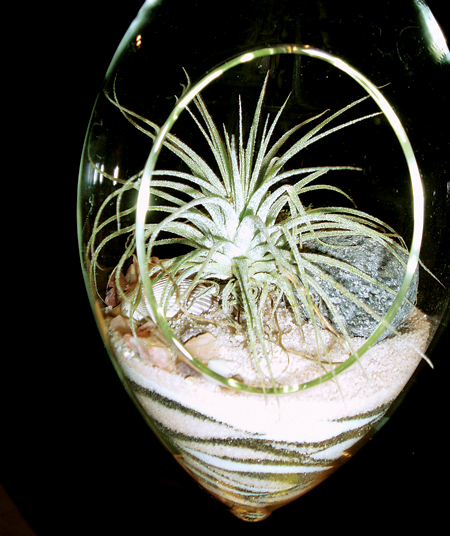AIR PLANTS PULL NUTRIENTS FROM AIR – Green-Thumb Gardener

Tillandsia, commonly called air plants, are epiphytes. As their common name implies, they pull moisture and nutrients from the air. They have no use for soil and any roots they might grow are used for grasping things, not for gathering water. Based on this, they have become very popular indoor plants in the last few years. The decorating possibilities are endless and you can find them sitting on many unique objects and in many non-traditional ‘plant’ positions.
There are over 600 varieties and many natural locations. Tropical tillandsia grow where it is moister and more humid. They usually have greener leaves that may look smooth and somewhat glossy. Xeric tillandsia grow in drier, less humid locations. They often have a white or silvery color with what looks like fuzz covering the leaves. Many types of tillandsia have a life span of 3 to 5 years or more, given appropriate conditions and care.
Their ideal growing conditions usually include temperatures between 50 and 90 degrees Fahrenheit. (Keep away from cold windows and air conditioning vents.) They require a minimum of 3 to 4 hours of bright, indirect light daily. Some seem to be able to do well in artificial indoor lighting. They can be watered by misting or dunking in water that covers the plant (avoid softened water). The frequency of watering depends on the environmental conditions they are in, the type of tillandsia (tropical need more and xeric need less), and the thickness of the leaves (thinner need more frequent watering). No matter which method you use, make sure to invert the plant for a short time after watering to dry so that water does not collect in the crown base. Otherwise, rot will likely set in. It is also important to not set the plant on a soil or moss type base as these retain water and can encourage rot to develop. Tillandsia leaves are covered with specialized tiny scales called trichomes that absorb water and nutrients from the air. They can also help shade the leaves from strong sun. These scales are what often give the leaves fuzzy or dusty looks.
Fertilize with orchid, bromeliad (plant cousins), or tillandsia fertilizer that is soluble in water that you dunk in. Follow the label instructions. It is important to not overfertilize. It is also best to check that the nitrogen in your fertilizer is not urea nitrogen as tillandsia cannot use this.
Experiment with locations for this interesting, easy to care for plant! See you local, independent garden center for options.
This article is sponsored by McNamara at Sand Point, which has 2 acres of production greenhouses, retail florist and gift shop, as well as retail garden center and wholesale plant business. Contact McNamara by calling 260-747-4131 or visit 4322 DeForest Ave, Ft. Wayne, IN 46809.
- Shamrock Search Leads To Adventures In Waynedale - March 29, 2024
- Take A Journey Back To The Hundred Acre Wood - March 29, 2024
- Recognizing Green Book Sites In Indiana - March 29, 2024


